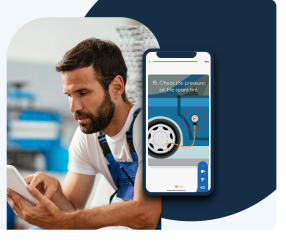Let’s be honest, delivering and monitoring compliance training courses isn’t the most exciting part of running your business, and they’re even less appealing to your employees. Yet they’re absolutely essential, especially for industries and positions that have training requirements mandated by local, state, or federal agencies. Failure to stay up-to-date can lead to fines or compromise safety on the job.
While compliance training courses are historically a bit dry and boring, they don’t have to be. By rethinking the way you deliver them, you can make the experience more engaging and interesting for employees, therefore boosting the likelihood that they’ll complete and remember their training.
Let’s explore the importance of compliance training programs, how you can improve your training delivery, and discover a list of examples to help you get started.
- What is compliance training?
- Why training delivery matters when it comes to compliance courses
- What features are essential in compliance training software?
- Make your compliance training mobile with TalentCards
- Why choosing a mobile training platform is best for deskless workers
- 20 examples of compliance training courses
- FAQs
- Key takeaways
What is compliance training?
Compliance training is training that educates your employees on company policies, proper procedures, laws and regulations, and/or overall safety standards that must be followed. The laws and regulations that dictate what is covered in compliance training tend to be established by local, state, and federal authorities.
Courses on compliance can have a positive impact on daily productivity. Properly trained staff can do their job with less supervision. This leads to an empowered workforce that takes ownership of what they do. The learning that comes out of these courses promotes workplace safety, and prevents the company from receiving penalties and fines.
It’s important to recognize that a well-executed training program goes beyond adherence to regulations. It helps cultivate a workplace culture that prioritizes safety and productivity. Team members feel secure in executing their tasks, knowing they can navigate potential challenges and make informed decisions.
Why training delivery matters when it comes to compliance courses
Getting an entire team to complete mandatory training can be challenging. It’s even more difficult when your workforce is distributed or you employ deskless workers. Not only that, but compliance training tends to be even more critical for deskless employees than it is for deskbound ones, due to the nature and physicality of their jobs.
So how do you get people scattered in different locations to complete critical training and do it on time?
By offering it on a platform that can go with them.
While traditional learning management systems work well for office-bound employees who complete training from laptops, this training delivery is not well-suited for deskless employees.
This is where mobile learning software comes in.
Mobile learning software is software that delivers training via mobile devices, like smartphones and tablets. But it doesn’t just take your laptop training and shrink it down to fit on a smaller screen. Courses and learning modules in mobile learning software embody a mobile-first design, meaning that they were designed to be completed on a mobile device.
By offering courses on compliance that is mobile optimized, you solve three really important challenges for your employees, deskless and deskbound alike:
- You make it available to access and complete from any location
- It’s self-paced, so training doesn’t have to interrupt the workday or sideline your employees
- It’s easy for managers to track completions, and automatically send reminders to employees
- You make it accessible on demand, so that employees can refresh and reinforce important safety concepts, even after checking the box of completing it once
Completing compliance training just to check a box isn’t worth the time or minimal effort. These lessons are here for a reason and retaining the learning matters.
There are plenty of compliance training vendors out there. Choosing the right one will make coordinating training a breeze. Your process becomes simplified and automated. Keep track of completion, send reminders, and reassign courses automatically.
What features are essential in compliance training software?
Mobile accessibility
Compliance training often carries a negative stigma, and rightfully so. In a world where people are constantly on the move, being tied down to a computer for hours of training is far from appealing. With compliance training software that offers mobile accessibility, your staff can complete their courses directly from their smartphones. Say goodbye to the constraints of traditional training and embrace a flexible and mobile learning experience.
Gamification
Turning mandatory compliance training into a friendly competition can help improve completion. Choose a mobile training platform that has built-in gamification features, such as points, badges, challenges, certificates, and leaderboards to naturally bring out your employees’ competitive side, boosting completion rates and engagement.
Spaced repetition
Providing your staff with spaced repetition training helps solidify learning. This technique presents material to the learner over and over as time goes on. Showing them the information at increased intervals helps improve memorization. Ensure your workforce can recall critical information with this proven method.
Analytics dashboard
Being able to look up analytics easily is invaluable. See where your staff is at with training progress, completion, and engagement over time. Understanding how many attempts your employees require to pass courses on compliance, and how long compliance training programs take to complete will help you identify problem areas and address them preemptively.
Make your compliance training mobile with TalentCards

Why choosing a mobile training platform is best for deskless workers
Thirty-two percent of companies that employ deskless employees report having experienced an accident due to improper employee training.
What’s more, only 17% of these companies reported that they use smartphones or tablets to deliver training to deskless employees, but 40% agreed that having a smartphone or tablet-based training platform in place would benefit the company.
Your deskless workers need flexibility with mandatory training. Since they’re already on the go, giving them the opportunity to complete training on a mobile device is a huge help, and it doesn’t have to increase your company’s equipment cost.
According to a recent study, 74% of frontline workers report feeling comfortable using their own mobile devices to complete training. The familiarity and accessibility of using their own device provides countless benefits.
Using a mobile training platform empowers employees with convenient, flexible, and engaging learning. Your business benefits from having a cost-effective, scalable, and efficient training solution.
20 examples of compliance training courses
While every business needs to incorporate compliance training, it won’t look the same for each one. It’s necessary to review what your business needs to comply with rules, regulations, and laws in your industry. Below you’ll find examples to get you started:
1. New hire safety orientation
Ensure new employees are equipped with essential safety guidelines and procedures.
2. Sexual harassment prevention training
Educate employees on recognizing and preventing sexual harassment in the workplace.
3. Diversity and inclusion training
Promote understanding and respect for diverse backgrounds and cultures.
4. Data privacy and protection
Learn how to safeguard sensitive data and comply with data privacy regulations.
5. Cybersecurity awareness
Enhance awareness of cyber threats and best practices for protecting digital information.
6. Equal employment opportunity (EEO) training
Understand the principles and legal requirements for promoting equal opportunities in the workplace.
7. Occupational safety and health (OSHA)
Learn OSHA regulations to maintain a safe and healthy work environment.
8. Workplace violence protection
Learn strategies to prevent and respond to incidents of workplace violence.
9. Emergency response and evacuation
Understand protocols and procedures for emergencies and safe evacuation.
10. HIPAA compliance
Understand regulations for protecting patient privacy and complying with HIPAA requirements.
11. Financial compliance and fraud protection
Learn about financial regulations and practices to prevent fraud and ensure compliance.
12. Social media use and policies
Understand guidelines for the appropriate and secure use of social media in the workplace.
13. Whistleblower protection and reporting
Familiarize employees with procedures for reporting concerns and protecting whistleblowers.
14. Anti-money laundering (AML)
Learn to recognize and prevent money laundering activities as per regulatory requirements.
15. Customer data protection
Understand measures to safeguard customer data and maintain privacy in compliance with regulations.
16. Forklift safety training
Gain the necessary skills and knowledge for safe forklift operation and maintenance.
17. Manual handling and lifting techniques
Learn proper techniques to prevent injuries while lifting and handling objects.
18. Fire safety and emergency preparedness
Enhance awareness of fire safety measures and preparedness for emergencies.
19. Conflict of interest training
Gain an understanding of conflicts of interest and how to navigate ethical dilemmas in the workplace.
20. Export compliance
Explore the regulations and requirements related to international trade and export compliance.
Deliver training to your deskless employees, no matter where the job takes them.

FAQs
What is compliance based training?
Compliance training is a critical part of employee training. It informs staff of rules, regulations, and laws they must follow at work.
What are examples of compliance training?
Each industry has regulations they must follow. To maintain your staff’s safety and protect your business, you should have a clear understanding of the compliance requirements.
A few examples are:
- Workplace safety training
- Data protection and privacy training
- Diversity training
- Regulatory compliance training
What is compliance training in healthcare?
Healthcare compliance training is designed to educate employees on their obligations regarding compliance and keep them updated on regulatory changes. It is a mandatory requirement for all healthcare facilities, ensuring that the organization and its providers:
- Establish policies, processes, and procedures that define acceptable behavior.
- Monitor and ensure adherence to these policies, processes, and procedures.
- Provide comprehensive training to staff members.
What is an ICA certificate?
An International Compliance Association (ICA) certificates are introductory level courses in areas of risk such as financial crimes.
Elevate your training experience
Compliance training courses are a must for any business. They don’t have to be the dreaded task that you just want to be done with. By utilizing mobile learning platforms, companies can provide flexible, convenient, and accessible training. Choosing the right mobile training platform makes them impactful and enjoyable. Intentionally implement your trainings to keep your employees safe while protecting your business.
Key takeaways
- Compliance training courses are essential for businesses to maintain regulatory compliance and promote workplace safety.
- Mobile learning platforms offer flexibility, convenience, and engagement for employees completing compliance training.
- Features such as mobile accessibility, gamification, spaced repetition, and analytics dashboards enhance the effectiveness of compliance training.
- Choosing a mobile training platform is advantageous for deskless workers, as it aligns with their on-the-go nature and offers familiarity.
- Tailoring compliance training courses to address specific regulatory requirements and industry needs ensures effective training outcomes.


